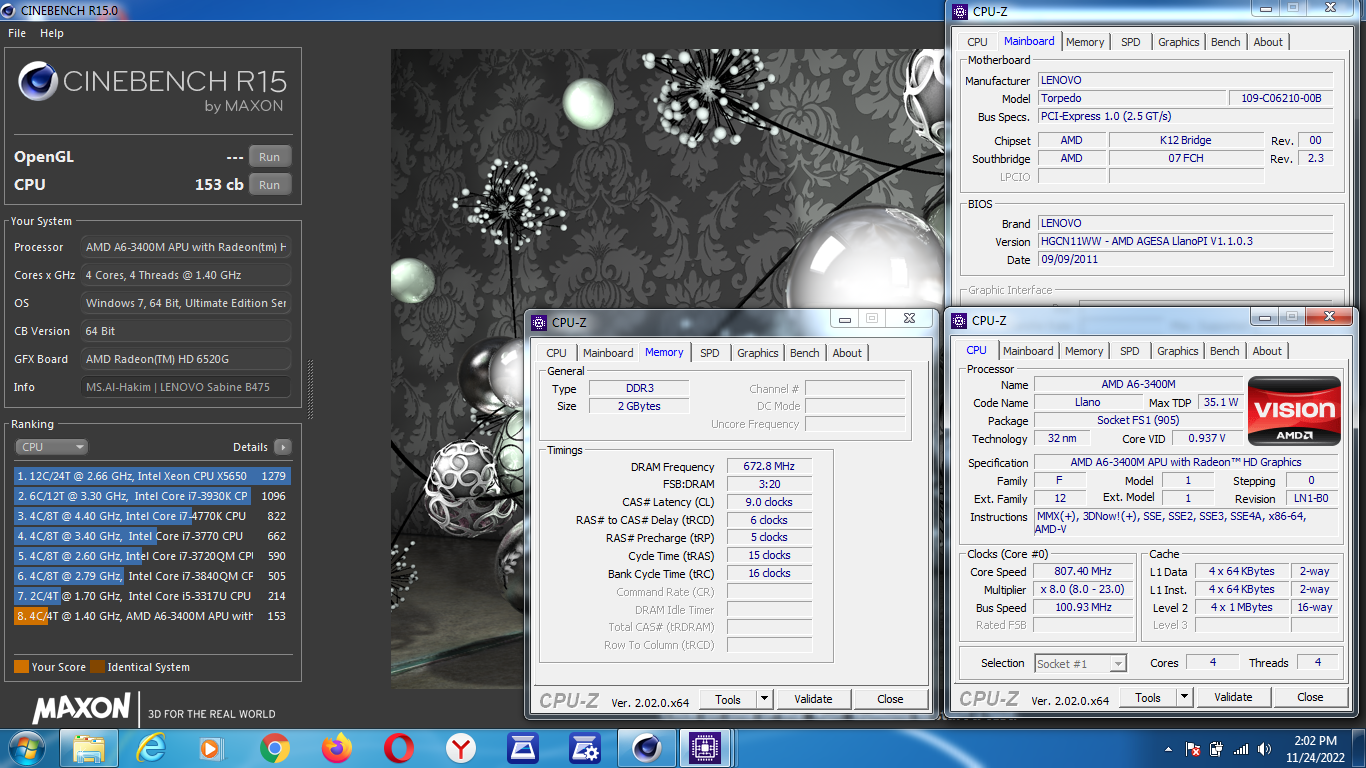Cinebench - R15 score 153 cb with a A6-3400M
Thursday, 24 November 2022 07:02 | Update at 2 years ago
Media Gallery
Screenshot

Device, Setup, etc


URL
https://hwbot.org/submission/5129937https://www.facebook.com/hakimnu.id/posts/pfbid02bLzdd8Y3SR3mFfbMVFFhFqh2pmggkSDPGysk43BPh6kht9xA13VjCCejNNRZBe4Rl
Information Detail
Hardware: AMD A6-3400M
Specs:CPUID : AMD A6-3400M APU with Radeon(TM) HD Graphics
Architecture : x86
Codename : Llano
L3 Cache : -
Clock : 1.4GHz - 2.3GHz
Core/Thread : 4/4
TDP : 35W
Technology : 32nm
Socket : PGA FS1 (905)
IGPU : AMD Radeon HD 6520G
See more specification...
Software: Cinebench - R15
Score: 153 cb
About: Cinebench - R15Cinebench R15 is one of the most popular CPU and GPU benchmarks developed by Maxon, the creator of CINEMA 4D software. Released at a time when quad-core processors were becoming commonplace, Cinebench R15 quickly became the standard tool for measuring the rendering performance of various types of desktop and laptop processors. This benchmark simulates the process of rendering photorealistic 3D graphics using the CINEMA 4D engine and assigns a score based on how quickly the CPU can complete the task.
In multi-core testing, Cinebench R15 utilizes all available threads and cores on the processor to render a complex scene consisting of over 300,000 polygons. This scene includes area lighting, soft shadows, sharp and blurry reflections, procedural textures, and anti-aliasing. All these elements are designed to place high stress on the entire CPU processing system, creating an environment that closely resembles real-world scenarios in digital content production or professional rendering.
Cinebench R15 scores are measured in “points” (pts), where higher numbers indicate better performance. This benchmark is ideal for evaluating rendering capabilities, multitasking performance, and overall processor efficiency, especially in applications that utilize multiple cores, such as Blender, Adobe Premiere, or CAD software.
Although Cinebench R15 has been replaced by newer versions like R20 and R23, Cinebench R15 is still widely used today due to its broad compatibility, lightweight execution, and consistent results. Especially for reviewers and users looking to compare processors across generations, R15 remains an important benchmark in the world of hardware and PC enthusiasts.
Released in mid-2011, the AMD A6-3400M is a mobile processor from the Llano family designed for the mid-range laptop segment. It has 4 cores and 4 threads with a base speed of 1.4 GHz that can increase to 2.3 GHz thanks to AMD's Turbo Core technology. Carrying a 32nm fabrication process, the A6-3400M offers good power efficiency with a TDP of 35W, making it a popular choice among conventional laptop users at the time. The main advantage of this processor lies not only in having enough cores for light multitasking, but also in the integration of an onboard GPU, the AMD Radeon HD 6520G. This GPU has 320 shader cores based on the Terascale 2 architecture, which is capable enough to run light graphics applications to older games with low resolution and graphics quality settings. The combination of CPU and GPU in one chip is designed to provide a balance between computing and graphics performance in one energy-efficient package.
In terms of performance, the A6-3400M can handle everyday computing needs such as browsing the internet, watching videos, listening to music, typing documents, and other light productivity tasks. However, in heavier usage scenarios or multitasking with many applications open at once, its performance starts to show limitations, especially when combined with a small RAM capacity such as 2GB. When compared to the same generation of Intel Core i3 processors, the A6-3400M does lag behind in single-thread performance, which is an important aspect for running modern applications that are not fully optimized for multi-core. In tests on a Lenovo Sabine B475 device with 2GB DDR3 RAM and Windows 7 operating system, the A6-3400M's performance showed that it is still quite responsive for light use, although it is no longer ideal for today's heavier workloads. Even so, the A6-3400M is still an attractive option for users who want a budget laptop with basic multimedia capabilities and a decent user experience for everyday needs.
Hardware Tested:
Device: Lenovo Sabine B475
RAM: 2GB DDR3
OS: Windows 7
* Not Avaiable
